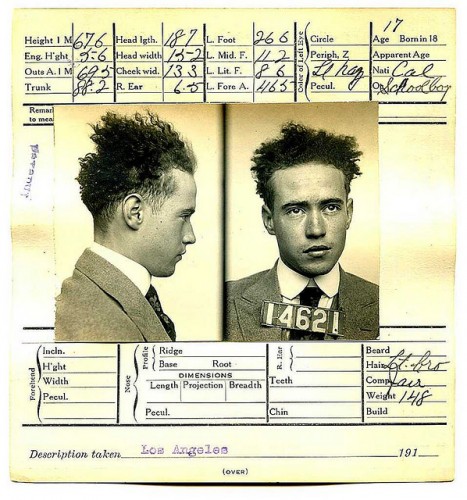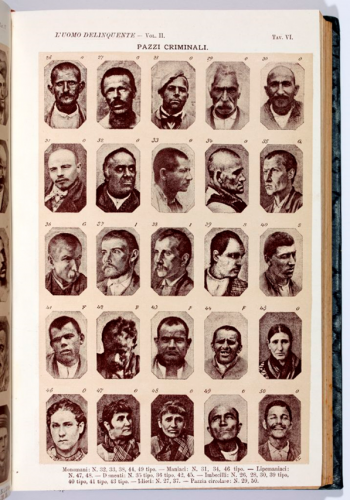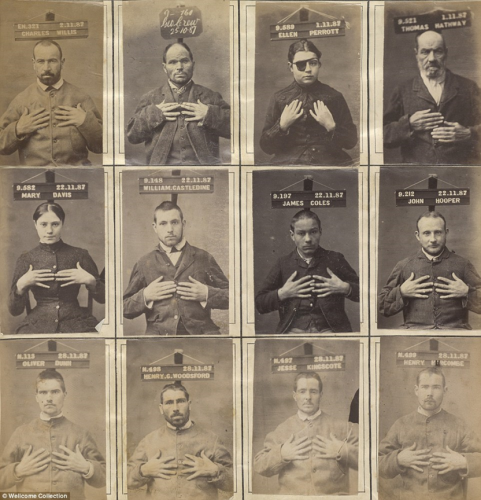
Visual technologies continue to play an increasingly key role in strategies for monitoring and surveillance in modern capitalist societies in crime prevention and detection, and the apprehension, recording, documenting and classification of criminals and criminal activities. Still and moving ‘visual evidence’ is stored in state archives, used in courtrooms as evidence, and disseminated across almost every major media platform: from the printed press to the World Wide Web.
The relationship between visual technologies and the criminal justice system can be traced back to the emergence of photography and the invention of the camera as a tool for documenting ‘reality’ in the nineteenth century. The camera was widely believed, even more so than today, to be able to objectively and truthfully record social reality. A photograph was perceived to be like a window on the world – a mechanically produced, impartial and literal representation of the real world.
Unlike oil painting and other forms of art, the camera required minimum human intervention and was therefore deemed to be free from the vagaries of human interpretation. Prior to the invention of photography and the wider availability of cameras, the criminal justice system relied heavily upon eye-witness accounts and written descriptions largely based on memory for the detection, identification, apprehension and sentencing of criminals.
The mid-nineteenth century was an era that was profoundly preoccupied with classification and order as evidenced by the application of the scientific method to occupations that were once considered more of an art than anything else. “The drive to produce taxonomies of race, social deviance and insanity so as to identify distinguishing ‘characteristics’ and thus predictable and recognisable social types was greatly aided by photographic technology.”1 The widely held-belief of the truth value (or factual nature) of the photographic image quickly slotted into the social and political regulatory systems of the time with newly emerging state bureaucratic and administrative networks of surveillance, power and authority. Photographic technology aided in the positivist reorganisation of knowledge 2.
The ascendant theories of criminology in the nineteenth century posited that an individual was born criminal and that criminal tendencies could be identified by physical indicators. This logic was underpinned by the use of criminal portraits which served the dual purpose of both the identification of criminals and to further support dominant theories about crime and criminality.
One such photographic taxonomy was produced by the Italian physician Cesare Lombroso who drew ink portraits depicting ‘criminal types’. Lombroso’s work is an exemplary case of the rise of positivist criminology in the nineteenth century. He argued that criminals possessed more ‘atavistic’ features and shared more characteristics with our evolutionary ancestors than more law-abiding citizens3. On the basis of post-mortem examinations of dead convicts and the extensive measurement and documentation of the distinguishing features of prison inmates, Lombroso proffered a form of explanation that attempted to establish a causal link between the physiological features of individuals in prisons and the types of crimes they were said to have committed. Such knowledge, Lombroso claimed, could offer a means of predicting criminality in the general populace.
Lombroso’s approach also combined phrenology (the study of the contours of the head) and the identification of anatomical stigmata (physiological features deemed to be ‘abnormal’) which came together in a general theory of biological determinism wherein physiological differences were assumed to be strong indicators of criminality or the propensity for deviant / criminal behaviour.

Not long after the publication of Lombroso’s work, French criminologist Alphonse Bertillon employed photography as a means for classifying and recording criminals combining visual documentation with the precise measurement of distinguishing bodily characteristics (distance between the eyes, length and width of the nose and so on) whilst Francis Galton developed (a then quite innovative) technique of exposing multiple portrait negatives which were then combined to form a single image highlighting shared characteristics displaying the inherent similarities between supposed criminal types. It is this sort of work, identifying composite criminal types and not just individuals, which forged the link between photography and the criminal justice system. Before long there were entire established professional disciplines (e.g. physiognomy and physical anthropology) that aimed to demonstrate the ways in which particular physical attributes indicated the propensity for criminality4.

As the nineteenth century progressed, official institutions of various kinds realised the value of the photograph for all kinds of purposes of classification and identification. Photography became increasingly deployed across a range of human, physical and biomedical sciences producing a unique fusion of knowledge, information and visualisation which assisted various state authorities in the power they exercised over citizens, making photography complicit in these new networks of administrative and bureaucratic power5. Initially, the uses of photography by the police varied considerably in terms of framing, composition and distance but through the work of Bertillon and Galton (amongst others) photographic practices quickly became refined and standardised.
By the twentieth century, the insights of Lombroso (and others working within these fields) were largely discredited on the grounds that far from offering objective evidence much of this work did nothing more than put a veneer of science on structural oppression. Many of the claims made about abnormality, pathology, deviance and criminality were deeply racist, classist and sexist in their implications6. Today, the work of Lombroso (and his contemporaries) now looks profoundly ethnocentric and androcentric, but an enduring and perhaps the most interesting aspect of this work is its visual legacy in the familiar and ubiquitous ‘mug-shot’ which is still widely used to this day.
In the twenty-first century, there is much talk about the death of photography or the notion that with digitalization we are now living in the post-photographic age. This argument does not seem to hold water, given that the relationship between the photographic image and the criminal justice system remains remarkably strong. The association between photography and criminal identification and apprehension firmly established in the nineteenth century is still alive and well today7.
But while the criminal portrait (or mug-shot) still occupies a prominent place in modern policing, these images no longer solely reside in the official domain of the archives of state authorities. As a form of visual evidence, the criminal portrait has not changed much over the years but digital networks have radically altered the means of their dissemination and circulation. This has prompted some critics to speculate these images have to some extent transcended their forensic roots.
Take, for example, the posting of the police mug-shot of criminal Jeremy Meeks on Stockton Police Force Facebook page resulted in his image going viral and concluding with the offer of a quite lucrative modelling contract. What is interesting about the Jeremy Meeks mug-shot story is that once his photograph was displayed outside of the authoritative domain of the police archive and publicly circulated across different social media platforms and networks it accrued different sets of meanings (sexy, hot, good-looking) along the way despite the attempt to officially encode (or fix) the meaning (criminal, dangerous, wanted by the police) of the photograph.

As David Banks’ article on Sousveillance reminds us, in an era where increasingly sophisticated digital and mobile tools and platforms have opened up the field of human communications in ways unimaginable 150 years ago, the boundaries between those with the power to observe and those who are the observed are increasingly subject to contestation and struggle. Power is never absolute or total and there will always be micro-pockets of resistance, counter-struggles and challenges to that power. The disempowered may become empowered in unintended or unanticipated ways.
According to the media scholar John Fiske8, in socially divided capitalist societies, dominant social groups use various forms of control to maintain their power which is reinforced and reproduced through the legal, political, educational and cultural systems. But this power can never be total, absolute, or complete – it is an on-going struggle between what Fiske terms the power-bloc and “the people”. Semiotic resistance (the interpretive power of “the people” to subvert, challenge, evade or resist dominant meanings and values which support the power-bloc) arises out of semiotic productivity – the interpretive ability to produce different or new meanings from the discourses, texts, resources and commodities produced by those in power. Rather than dismiss these instances of semiotic resistance as irrelevant, Fiske sees them as important (albeit minor) victories of the subordinate against a system that constantly seeks to socially divide, dominate, monitor and exert forms of control over them.
Fiske’s theory was formulated in the late 1980s and so pre-dates the emergence of web 2.0 and social media but his model of culture (and popular culture) does have a resonance with the ways in which social media tools and platforms further open up the terrain of culture for struggles over meaning, semiotic productivity and popular resistance. Imposing official (or dominant) meanings is now much more difficult because there are so many opportunities for contestation. It would be naïve to cite the Jeremy Meeks example as some kind of paradigm changing moment or as the empowerment of the masses but it does offer an insight into the ways in which the potential for popular resistance is always possible and can surface in the most unlikely of places.
Liam French is a lecturer in the Journalism and Media Department at the University of St. Mark & St. John.
References & Further Reading
1 Jermyn, D. (2007) Crime Watching: Investigating Real Crime TV. New York, I.B. Tauris
2 McQuire, S. (1998) Visions of Modernity. London, Sage Publications.
3 Smith, M.J. (2003) Social Science in Question. London, Sage Publications.
4 Jermyn, D. (2007) Crime Watching: Investigating Real Crime TV. New York, I.B. Tauris
5 Tagg, J. (1988) The Burden of Representation: Essays on Photographies and Histories. New York. Palgrave MacMillan.
6 Klein, D. (1996) The Etiology of Female Crime, in Muncie, J., McLaughlin, E. & Langan, M. (eds) Criminological perspectives: a Reader. London, Sage Publications.
7 Jermyn, D. (2007) Crime Watching: Investigating Real Crime TV. New York, I.B. Tauris
8 Fiske, J. (1989) Reading the Popular. London & New York. Routledge. See also Television Culture (1987) and Understanding Popular Culture (1989) by the same author.
IMAGE SOURCES / CREDITS:
Cesare Lombroso (1876) L’Uomo Delinquente: http://www.lib.cam.ac.uk/exhibitions/Babies/pictures/big/8600.c.97_tableVI.jpg (accessed 6th June 2015)
Plymouth Crime Gang Broken by Undercover Police Operation. Plymouth Herald 25th March 2014: http://www.plymouthherald.co.uk/Plymouth-crime-gang-broken-undercover-police/story-20846710-detail/story.html (accessed 5th June 2015)
The Hands of Justice: Fascinating Nineteenth Century Mug-shots Show Criminals Displaying Their Fingers for the Camera to Reveal Tattoos or Even Missing Digits: http://www.dailymail.co.uk/news/article-2967021/Whodunnit-shattered-skulls-real-life-game-Guess-new-exhibition-lifts-lid-morbid-fascination-forensics.html (accessed 5th June 2015)
